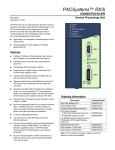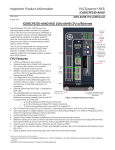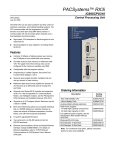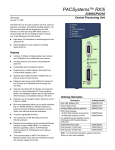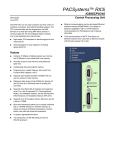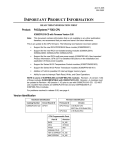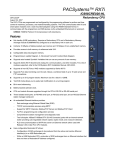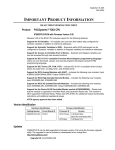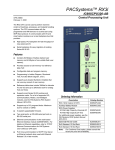Download PACSystems RX3i CPUs, IC695CPU310-EP, v. 5.00, GFK
Transcript
PACSystems™ RX3i IC695CPU310-EP Central Processing Unit GFK-2329S August 27, 2007 CPU OK The RX3i CPU can be used to perform real time control of machines, processes, and material handling systems. The CPU communicates with the programmer and HMI devices via a serial port using SNP Slave protocol. It communicates with I/O and smart option modules over a dual backplane bus that provides: ■ ■ High-speed, PCI backplane for fast throughput of new advanced I/O. Serial backplane for easy migration of existing Series 90-30 I/O RUN OUTPUTS DISABLED I/O FORCE BATTERY SYSTEM FAULT RESET STOP CPU310 RUN I/O ENABLE RUN OUTPUT DISABLE COM 1 Features ■ Contains 10 Mbytes of battery-backed user memory and 10 Mbytes of non-volatile flash user memory. ■ Provides access to bulk memory via reference table %W. ■ Configurable data and program memory. ■ Programming in Ladder Diagram, Structured Text, Function Block Diagram, and C. ■ Supports auto-located Symbolic Variables that can use any amount of user memory. ■ Reference table sizes include 32Kbits for discrete %I and %Q and up to 32Kwords each for analog %AI and %AQ. ■ Supports most Series 90-30 modules and expansion racks. For a list of supported I/O, Communications, Motion, and Intelligent modules, see the PACSystems RX3i Hardware and Installation Manual, GFK-2314. ■ Supports up to 512 program blocks. Maximum size for a block is 128KB. ■ Bit-in-word referencing allows you to specify individual bits in a WORD reference in retentive memory as inputs and outputs of Boolean expressions, function blocks, and calls that accept bit parameters. ■ In-system upgradeable firmware. ■ Two serial ports: an RS-485 serial port and an RS-232 serial port. ■ Ethernet communications via the rack-based Ethernet Interface module (IC695ETM001). For details on Ethernet capabilities, refer to TCP/IP Ethernet Communications for PACSystems User’s Manual, GFK-2224. ■ PLC time synchronization to SNTP Time Server on Ethernet network when used with Ethernet Release 5.0 or later module. COM1 ACTIVE COM2 ACTIVE COM 2 BATT Ordering Information Description Catalog Number RX3i VME 300Mhz CPU IC695CPU310 Lithium Battery Pack IC698ACC701 Auxiliary Battery Module (optional) IC693ACC302 RX3i Power Supplies 40 Watt High Capacity Universal AC 40 Watt High Capacity 24 VDC For additional power supplies, see the PACSystems RX3i System Manual, GFK-2314. IC695PSA040 IC695PSD040 [Optional] RS-232 Cable IC200CBL001 Rx3i Standard 12 Slot Rack IC695CHS012 Rx3i Standard 16 Slot Rack IC695CHS016 Note: For Conformal Coat option, please consult the factory for price and availability. 2 RX3i CPU GFK-2329S Operation, Protection, and Module Status Firmware Storage in Flash Memory Operation of this module can be controlled by the threeposition RUN/STOP switch or remotely by an attached programmer and programming software. Program and configuration data can be locked through software passwords. The status of the CPU is indicated by the eight CPU LEDs on the front of the module. (See “LED Operation” on page 5) This CPU uses non-volatile flash memory for storing the operating system firmware. This allows firmware to be updated without disassembling the module or replacing EPROMs. The operating system firmware is updated by connecting a PC compatible computer to the module’s RS-232 serial port and running the software included with the firmware upgrade kit. Battery Installation A three-cell lithium battery pack (IC698ACC701) is installed as shown in the figure below. The battery maintains program and data memory when power is removed and operates the calendar clock. When replacing the battery, be sure to install a new battery before disconnecting the old one. Disposal of lithium batteries must be done in accordance with federal, state, and local regulations. Be sure to consult with the appropriate regulatory agencies before disposing of batteries. Mode Switch and Battery Compartment To avoid loss of RAM memory contents, routine maintenance procedures should include scheduled replacement of the CPU’s lithium battery pack. For information on estimating battery life, refer to the PACSystems CPU Reference Manual, GFK-2222. User RAM Memory The CPU has 10 Mbytes of battery-backed CMOS RAM memory for user data (program, configuration, register data, and symbolic variable) storage. User Flash Memory The CPU has 10 Mbytes of built-in flash memory for user data (program, configuration, register data, and symbolic variable) storage. Use of this flash memory is optional. It is the responsibility of the OEM, system integrator, or end user to properly install the control system equipment for safe and reliable operation. Product manuals provide detailed information about installation, startup, and proper use of the control system equipment. Installation should not be attempted without referring to the PACSystems RX3i Hardware and Installation Manual, GFK-2314. 1. Make sure that rack power is off. 2. Install the CPU module in rack 0. The CPU requires two slots and can use any slots except the highest numbered (rightmost) slot. Ensure mounting screws are tightened to completely secure the CPU in the rack. 3. Turn on power. The module should power up. When the CPU has successfully completed initialization, the OK LED stays on and the RUN and EN LEDs are off. The CPU is now ready to be programmed. 4. Connect the battery to either of the battery connectors on the module. (You can connect the battery at any step in the installation process but it will begin to drain immediately unless power is applied. To maximize battery life, install it after power has been turned on). After the program has been verified, the mode switch can be moved to the appropriate operation mode position: RUN I/O ENABLED, RUN OUTPUT DISABLE, or STOP. The LEDs indicate the position of the mode switch and status of serial port activity. For details, see “LED Operation” on page 5. RX3i CPU 3 GFK-2329S Serial Cable Lengths and Shielding Programmer Connection The programmer can communicate with the CPU via the serial port 1, serial port 2, or the rack-based Ethernet interface. If you connect your programmer via an Ethernet TCP/IP network, you will need a CAT5 standard Ethernet cable with RJ-45 connectors. Before connecting the programmer and RX3i to the Ethernet TCP/IP network you must set the IP address, using the Initial IP Address software tool. After setting the IP address, connect the RX3i and the computer running the programming software to the Ethernet Interface. For detailed information on programmer connection via Ethernet TCP/IP, refer to the TCP/IP Ethernet Communications for PACSystems User’s Manual, GFK-2224. For a description of programming functions, consult Proficy™ Machine Edition Logic Developer-PLC Getting Started, GFK-1918 and the software online help. Serial Ports The CPU has two independent, on-board serial ports, accessed by connectors on the front of the module. These ports provide serial interfaces to external devices. The connection from a CPU serial port COM1 to the serial port on a computer or other serial device requires a serial cable. This connection can be made with the IC200CBL001 cable kit or you can build cables to fit the needs of your particular application. See the PACSystems CPU Reference Manual, GFK-2222 for more information on serial communications, cables, and converters. Maximum cable lengths (the total length from the CPU to the last device attached to the serial cable) are: ■ Port 1 (RS-232) – 15 meters (50 ft.), shielded cable optional ■ Port 2 (RS-485) – 1200 meters (4000 ft.), shielded cable required Port 1 Port 1 (COM1) is RS-232 compatible. It has a 9-pin, female, D-sub connector with a standard pin out. This is a DCE (data communications equipment) port that allows a simple straight-through cable to connect with a standard AT-style RS-232 port. The COM1 Active LED provides the status of serial port activity. Protocols Supported Protocol Port 1 RS-232 Signals Port 1 Pin Number Port 2 Signal Name Description RTU (slave) Yes Yes SNP Slave Yes Yes 1* NC No Connection Yes 2 TXD Transmit Data Receive Data Serial I/O Yes Firmware Upgrade RX3i in STOP/No I/O mode 3 RXD Message Mode (C Runtime Library Functions: serial read, serial write, sscanf, sprintf) Yes 4 DSR Data Set Ready 5 0V Signal Ground 6 DTR Data Terminal Ready 7 CTS Clear To Send 8 RTS Request to Send 9 NC No Connection Yes Serial Port Baud Rates Protocol Port 1 (RS-232) Port 2 (RS-485) Modbus RTU Slave protocol 1200, 2400, 4800, 9600, 19.2K, 38.4K, 57.6K, 115.2K Message 1200, 2400, 4800, 9600, 19.2K, 38.4K, 57.6K, 115.2K Firmware Upgrade via Winloader 2400, 4800, 9600, 19.2K, 38.4K, 57.6K, 115.2K SNP Slave 1200, 2400, 4800, 9600, 19.2K, 38.4K, 57.6K, 115.2K Serial I/O 1200, 2400, 4800, 9600, 19.2K, 38.4K, 57.6K, 115.2K * Pin 1 is at the bottom right of the connector as viewed from the front of the module. 4 RX3i CPU GFK-2329S Port 2 Configuration Port 2 (COM2) is RS-485 compatible. Port 2 has a 15-pin, female D-sub connector. This port does not support the RS-485 to RS-232 adapter (IC690ACC901). This is a DCE port. The RX3i CPU and I/O system is configured with Machine Edition PLC-Logic Developer programming software. The COM2 Active LED provides the status of serial port activity. Port 2 RS-485 Signals Pin No. Signal Name Description 1* Shield Cable Shield 2 NC No Connection 3 NC No Connection 4 NC No Connection 5 +5VDC Logic Power** 6 RTS(A) Differential Request to Send 7 0V Signal Ground 8 CTS(B‘) Differential Clear To Send 9*** RT Resistor Termination 10** RD(A‘) Differential Receive Data 11 RD(B‘) Differential Receive Data 12 SD(A) Differential Send Data 13 SD(B) Differential Send Data 14 RTS(B) Differential Request To Send 15 CTS(A’) Differential Clear To Send * Pin 1 is at the bottom right of the connector as viewed from the front of the module. ** Pin 5 provides isolated +5VDC power (300mA maximum) for powering external options. *** Termination resistance for the RD A’ signal should be connected on units at the end of the line. To make this termination, connect a jumper between pins 9 and 10 inside the 15-pin D-shell. The CPU verifies the actual module and rack configuration at power-up and periodically during operation. The actual configuration must be the same as the programmed configuration. Deviations are reported to the CPU alarm processor function for configured fault response. Refer to the Proficy Machine Edition Logic Developer-PLC Getting Started Manual, GFK-1918 and the online help for a description of configuration functions. Ethernet Global Data (EGD) Each RX3i CPU supports up to 255 simultaneous Ethernet Global Data (EGD) exchanges across all Ethernet interfaces in the PLC. EGD exchanges must be configured in the programming software and stored into the CPU. The EGD configuration can also be loaded from the CPU into the programming software. Both produced and consumed exchanges can be configured. RX3i CPUs support using only part of a consumed EGD exchange. EGD exchange production and consumption can use the broadcast IP address of the local subnet. The RX3i CPU supports 2msec EGD exchange production and timeout resolution. RX3i EGD exchanges can be configured for a production period of 0, indicating the exchange is to be produced every output scan. These “as fast as possible” exchanges are not produced more often than 2msec. RX3i CPUs support enhanced EGD freshness, providing better EGD timeliness than Series 90-30 CPU products. During EGD configuration, RX3i Ethernet interfaces are identified by their Rack/Slot location. Firmware Upgrades The CPU receives firmware upgrades through a CPU serial port. To install a firmware upgrade, connect WinLoader to the CPU RS-232 or RS-485 serial port. Since you are connecting directly to the CPU, there is no need to specify the Rack/Slot location. For upgrades to smart modules (the IC695ETM001, for example), which are performed indirectly via the CPU serial port, you must specify a rack/slot location. RX3i CPU 5 GFK-2329S LED Operation The following table lists the CPU LED functions during normal operation (after initialization sequence is complete). LED State On Blinking CPU Operating State Off CPU OK On CPU has passed its powerup diagnostics and is functioning properly. CPU OK Off CPU problem. RUN and OUTPUTS ENABLED LEDs may be blinking in an error code pattern, which can be used by technical support for troubleshooting. This condition and any error codes should be reported to your technical support representative. CPU OK, OUTPUTS ENABLED, RUN Blinking in unison RUN On RUN Off CPU is in boot mode and is waiting for a firmware update through serial port. CPU is in Run mode CPU is in Stop mode. OUTPUTS ENABLED On Output scan is enabled. OUTPUTS ENABLED Off Output scan is disabled. I/O FORCE On Override is active on a bit reference. BATTERY Blinking Battery is low. BATTERY On Battery is dead or not attached. SYSTEM FAULT On COM1 COM2 Blinking Blinking CPU is in Stop/Faulted or Stop/Halted mode. Signal activity on port. Specifications* IC695CPU310 Battery: Memory retention For estimated battery life under various conditions, refer to the PACSystems CPU Reference Manual, GFK-2222. Program storage Up to 10 Mbytes of battery-backed RAM 10 Mbytes of non-volatile flash user memory Power requirements +3.3 VDC: 1.25 Amps nominal +5 VDC: 1.0 Amps nominal Operating Temperature 0 to 60°C (32°F to 140°F) Floating point Yes Boolean execution speed, typical 0.195ms per 1000 Boolean contacts/coils Time of Day Clock accuracy Maximum drift of 2 seconds per day Elapsed Time Clock (internal timing) accuracy 0.01% maximum Embedded communications RS-232, RS-485 Serial Protocols supported Modbus RTU Slave, SNP, Serial I/O Backplane Dual backplane bus support: RX3i PCI and 90-30-style serial PCI compatibility System designed to be electrically compliant with PCI 2.2 standard Program blocks Up to 512 program blocks. Maximum size for a block is 128KB. Memory %I and %Q: 32Kbits for discrete %AI and %AQ: configurable up to 32Kwords %W: configurable up to the maximum available user RAM Symbolic: configurable up to 10 Mbytes * For environmental specifications and compliance to standards (for example, FCC or European Union Directives), refer to the PACSystems RX3i Hardware and Installation Manual, GFK-2314. 6 RX3i CPU GFK-2329S Release Information Firmware release 5.00 contains the new features listed in “New Features and Enhancements” on page 8 and corrects the issues listed in “Problems Resolved by this Revision of Product” on page 7. This release supports Proficy Process Systems Release 1.00. Updates IC695CPU310 can be field-upgraded to firmware version 5.00 using the firmware upgrade utility. The upgrade kit, 44A752290-G16, can be downloaded at no charge from http://support.gefanuc.com or purchased. Release History Catalog Number Firmware Version Date IC695CPU310-EP 5.00 Aug. 07 IC695CPU310-EN 3.83 Nov. 06 IC695CPU310-EM 3.82 Jul. 06 IC695CPU310-EL 3.81 May 06 IC695CPU310-DK 3.52 Jan. 06 IC695CPU310-DJ 3.51 Nov. 05 IC695CPU310-DH 3.50 Sep. 05 IC695CPU310-CG 3.12 Aug. 05 IC695CPU310-CF 3.11 Jun. 05 IC695CPU310-CD 3.00 Apr. 05 IC695CPU310-CC 2.90 Dec. 04 IC695CPU310-CB 2.80 Nov. 04 IC695CPU310-CB 2.51 Nov. 04 IC695CPU310-BB 2.51 Jul. 04 IC695CPU310-AA 2.50 (initial release) Jun. 04 CPU Functional Compatibility Subject Description Programmer Version Requirements Proficy® Machine Edition Logic Developer 5.7 is required to use the new Release 5.0 features with the RX3i CPU. Proficy Machine Edition Logic Developer 5.5 with Service Pack 2 Sim 4 is required to use the new CMM serial modules with the RX3i CPU. Proficy Machine Edition Logic Developer 5.5 with Service Pack 1 is required to use the 8 ETM feature with the RX3i CPU. Proficy Machine Edition Logic Developer 5.5 or later must be used to for new features in PACSystems 3.50 and later. Proficy Machine Edition Logic Developer 5.0 or later must be used to configure and program the RX3i. Service Pack 3 is required to support the new features in PACSystems 3.00. C Toolkit Compatibility C Toolkit Release 5.00 Build 16C1 is required when the PACSystems CPU contains firmware Release 5.00 or later. C Toolkit Release 3.50 Build 34A1 is required for new features in PACSystems Release 3.50 and later (Use of variables in C Blocks). The C Toolkit for PACSystems is also distributed with Proficy® Machine Edition Logic Developer 5.0 or greater. Toolkit Release 2.50 build 50A1 or later is required for use with the RX3i. Please note: The Series 90 Toolkit (IC641SWP709/719) is not compatible with PACSystems. Note: All C blocks must be recompiled using the new toolkit before downloading to a PLC CPU that contains Release 5.00 firmware. RX3i CPU 7 GFK-2329S Backplanes, power supplies and system modules As listed in the PACSystems RX3i System Manual, GFK-2314C or later. Problems Resolved by this Revision of Product Subject Description GBC30 or "smart" analog In RX3i PLC systems with a very high level of interrupt activity, the CPU could lose modules could stop communication with GBC30, ALG222, ALG223, ALG442. This will not occur using Release 5.0. communicating with PLC CPU310 PLC Total Used Memory showed used memory greater than available memory In certain rare occasions after repeated stores of User Logic or Run-Mode-Stores of User Logic, the PLC may indicate that the Total Used memory exceeds the available User memory in the PLC. The PLC will subsequently reject any store requests with an error message indicating that there is not enough memory available, even after clearing User memory. This behavior has been corrected. "Address out of range" message is vague A new error code (59) has been added to the application faults (group 22). It occurs when a parameterized subroutine block is called by a block whose %L or %P memory is not large enough Reference data not loaded from flash In rare instances, during a power up, reference table data was preserved in RAM even if "Load from Flash" was specified and a good battery was connected to the CPU. This failure only occurred if the CPU had been powered down while loading reference tables from flash during a previous power up with the battery connected. With this release (5.0), a "Controller Sequence Store Failure" Fault appears in the PLC fault table and the PLC enters STOP FAULT mode when this condition occurs. Deleting many blocks in a Deleting a large number of blocks (approximately 100 or more) could cause the watchdog timer run mode store caused to expire at the default setting. The number of blocks required to cause this increased as the watchdog expiration watchdog timeout was increased. This problem has been resolved in version 5.00. Some very large writes to In previous releases, a very large target, especially one that contained a large %W memory flash failed table, may not write to flash successfully. During the download, Proficy Machine Edition would automatically disconnect and the CPU may enter STOP HALT mode. The error “Fatal Store Failure – User Flash has been cleared” would appear in the fault table. A power cycle recovered the PLC to a normal state. This behavior has been corrected. Incorrect RX3i hot swap Removing an IC693APU300 and replacing a different module into that slot would cause the PLC action could cause STOP CPU to enter STOP HALT mode. This behavior has been corrected. HALT mode. Download of projects A project containing a large number of EGD produced exchanges with large (more than 200 with many EGD variables variables) exchanges could not be downloaded to the PLC. The PLC fault table displayed a could fail "Controller sequence store failure". This behavior has been corrected. Extraneous fault bits When a remote rack was lost, all fault locating references for the entire local rack would be set. were set for remote (e.g. With this release, only the appropriate bits are set. GNIU, GR7) loss-of-rack faults 8 RX3i CPU GFK-2329S New Features and Enhancements Scan Set I/O – The SCAN_SET_IO function block scans the I/O of a specified scan set number. Modules are assigned to scan sets in hardware configuration. An operand of the block specifies whether the Inputs and/or Outputs of the associated scan set will be scanned. The Scan Set IO function skips modules that do not support DO_IO scanning. Quality Function Blocks – This group of instructions adds capabilities to determine the quality of the data that is used in an application. The quality functions will determine whether a data item was transmitted without error from an input device into an I/O module or from an I/O module to an output device. Optional Parameters in UDFBs - The ArgPresent function allows logic inside a UDFB or PSB to know if an input argument for a particular parameter was present or not present. This is useful for optional parameters. IEC Transitionals - The IEC 61131-3 PLC programming standard defines two edge detector function blocks. The “Rising edge trigger” R_TRIG and “Falling edge trigger” F_TRIG detect the changing state of a Boolean signal. Synchronizing the High-resolution Time of Day Clock to an SNTP Network Time Server – This new synchronization capability allows you to set a consistent time across multiple systems. Once the CPU TOD clock is synchronized with the SNTP time, all produced EGD exchanges will use the CPU’s TOD for the time stamp. Using this feature requires the Ethernet Advanced User Parameter “ncpu_sync” and a COMMREQ in the user logic. Also, use of this feature requires both CPU firmware release 5.00 or later and Ethernet firmware release 5.00 or later. CPU Restrictions and Open Issues Subject Description Battery installation When installing a new battery, when there currently is no battery installed, the battery must be installed while the CPU has power. Failing to follow this procedure could result in the CPU not powering up. If a battery is installed while power is off (and there was no battery previously installed), and the CPU fails to power up, simply remove the battery, power cycle the CPU and then install the battery. Hot Swapping some Analog modules slowly may result in modules not being recognized Occasionally during a hot insertion (hot swap) of IC695 Non-Isolated Analog Input Modules, input channels may take up to 2 seconds to reflect actual input values after the module OK bit is enabled in the module status word. This delay has only occurred when the hot insertion has been done slowly (i.e. approximately 1.5 seconds to insert the module) Ethernet Disconnect During Word-for-Word Change If the Ethernet connection is broken during a word-for-word change, the programmer may not allow a subsequent word-for-word change after reconnecting due to the fact that it thinks another programmer is currently attached. If this occurs, you should go offline and then back online again. Simultaneous Clears, Loads and Stores Not Supported Currently, PACSystems CPUs do not support multiple programmers changing CPU contents at the same time. The programming software may generate an error during the operation. Simultaneous loads from a single PLC are allowed. Hardware Configuration and Initial Values May Not Load From Flash If no user logic exists in the CPU RAM when a write to flash is performed, the CPU may not properly load from flash after a power cycle. In order to guarantee proper power up from flash, insure that both hardware configuration and logic have been stored to RAM before writing to flash. Power Cycle During Write to Flash If the CPU is power cycled during the process of writing to flash, and is configured to power up from flash, a fault will be generated on power up. Hardware Configuration Not Equal After Changing Target Name If the user stores a hardware configuration to flash that sets “Logic/Config Power up Source” to “Always Flash” or “Conditional Flash” and then subsequently changes the name of the target in the programming software, the hardware configuration will go Not Equal and will not Verify as equal. PLC and IO Fault Tables May Need to be Cleared Twice to Clear Faulted State Both PLC and IO fault tables may need to be cleared to take the CPU out of Stop/Fault mode. If one of the tables contains a recurring fault, the order in which the tables are cleared may be significant. If the CPU is still in Stop/Fault mode after both tables are cleared, try clearing the fault tables again. RX3i CPU 9 GFK-2329S Subject Description Setting Force On/Off by Storing Initial Value Once a force on or force off has been stored to the PLC, the user cannot switch from force on to force off or vice-versa directly by downloading initial values. The user can turn off the force by doing a download, and then change the force on or off by another download. Number of Active Programs Returned as Zero The SNP request Return Controller Type and ID currently returns the number of active programs as zero. Serial I/O Failure at 115K During Heavy Interrupt Load Rare data corruption errors have been seen on serial communications when running at 115K under heavy interrupt load on the PLC. Under heavy load applications, users should restrict serial communications to 57K or lower. SNP ID not always provided Unlike the Series 90-30, the RX3i CPU’s SNP ID will not appear in the Machine Edition programmer Show Status display. Service Request 11 will always return zeros. Second programmer can change logic while in Test & Edit mode While currently active in a Test and Edit session using Machine Edition on one PC, Machine Edition running on another PC is not prevented from storing new logic to the PLC. Must Have Logic If PoweringUp From Flash If the application will configure the CPU to retrieve the contents of flash memory at power-up, be sure to include logic along with hardware configuration when saving to flash memory. Two loss of module faults for Universal Analog Module Occasionally, the hot removal of the Universal Analog Input Module (IC695ALG600) results in two “Loss of I/O Module” faults instead of one. Power up of HSC may take as long as 20 seconds As power is applied to a 90-30 High-Speed Counter, the "module ready" bit in the status bits returned each sweep from the module may not be set for as long as 20 seconds after the first PLC sweep, even though there is no "loss of module" indication. I/O data exchanged with the module is not meaningful until this bit is set by the module. For details, see “Data Transfer Between High Speed Counter and CPU” in the Series 90-30 High Speed Counter User’s Manual, GFK-0293C. Info fault at power up Intermittently during power-up, an Informational non-critical CPU software fault may be generated with fault extra data of 01 91 01 D6. This fault will have no effect on the normal operation of the PLC. But, if the hardware watchdog timer expires after this fault and before power has been cycled again, then the outputs of I/O modules may hold their last state, rather than defaulting to zero. Extended Memory Types for IO Triggers %R, %W and %M cannot be used as IO triggers. Possible Machine Edition inability to connect Infrequently, an attempt to connect a programmer to a PLC via Ethernet will be unsuccessful. The normal connection retry dialog will not be displayed. Rebooting the computer that is running the programmer will resolve the behavior. SNP Update Datagram message If an Update Datagram message requests 6 or less bits or bytes of data, the PLC will return a Completion Ack without Text Buffer. The protocol specifies that the returned data will be in the Completion Ack message, but it may not be. GBC30 may not resume operation after power cycle In rare instances, a GBC30 in an expansion rack may not resume normal operation after a power cycle of either the expansion rack or the main rack. Configuration of third-party modules Do not specify a length of 0 in the configuration of a third-party module. The module will not work properly in the system. Power supply status after CPU firmware update The PLC will report a “Loss of or missing option module” fault for the IC695PSD140 RX3i power supply following an update of PLC CPU firmware. Also, the slot will appear empty in the programmer’s online status detail view. The power supply continues to operate normally. Power cycle to restore normal status reporting. Power supply status after power cycling Rarely, turning a power supply on or off may not result in an add or loss fault. Also, the slot will appear empty in the programmer’s online status detail view. The power supply continues to operate normally. Power cycle to restore normal status reporting. Don’t use multiple targets In a system in which the hardware configuration is stored from one target and logic is stored from a different target, powering-up from flash will not work. The observed behavior is that, following a power up from flash, ME reports hardware configuration and logic "not equal". 10 RX3i CPU GFK-2329S Subject Description Missing “Loss of terminal block” fault The IC695ALG600/608/616 analog input modules do not produce a “Loss of terminal block” fault when hardware configuration is stored or the module is hot-inserted, and the terminal block is not locked into place. Sequence Store Failure In systems with very large hardware configurations, it is possible to encounter a “PLC Sequence Store Failure” error when writing the configuration to flash. To work around this error, either: 1. Perform an explicit clear of flash prior to performing the write. 2. Increase the operation timeout used by Machine Edition software prior to performing the write. IC694MDL754: Must configure module status bits Always configure 16 bits of module status when using this module. Configuring 0 bits of module status will result in invalid data in the module’s ESCP status bits. IC695ALG600 Lead Resistance Compensation setting A configuration store operation will fail if a channel is configured for 3-wire RTD and Lead Resistance Compensation is set to Disabled. A Loss of Module fault will be logged in the I/O Fault table at the end of the store operation. To recover the lost module, the configuration must be changed to enable Lead Resistance Compensation and module must be power cycled. C Toolkit PlcMemCopy Documentation Incorrect This routine does allow the destination and source pointers to be outside of reference memory. If the destination points to discrete reference memory, overrides and transitions will be honored. Note that the header for PlcMemCopy has been updated in Release 3.50 of the C toolkit. Flash clear operation may fail unexpectedly Occasionally flash clears may fail when the CPU is configured to load hardware config and logic from flash with a battery attached. If this occurs, remove the battery and power cycle to resolve the issue. WinLoader may stop operating On computers running Windows 2000 and using some versions of Symantec Antivirus protection, WinLoader will fail if used in advanced mode. Recovery requires cycling the computer's power. Storing a Configuration w/EGD to Mismatched Module Prevents Future Stores Storing a configuration that causes a mismatch for an Ethernet module with EGD configured causes the CPU to get into a state where all future stores will fail. The remedy is pulling the battery and power cycling. Issues Related to the IC693DNM200 DeviceNet Master Module Please see GFK-2194C or later for open issues related to the IC693DNM200 DeviceNet Master Module. RX3i CPU 11 GFK-2329S CPU Operational Notes Subject Description Length of Serial I/O buffer (Release 5.0 or later) The "Set Up Input Buffer Function" always allocates a buffer containing 2049 bytes. This is one byte more than previous PACSystems releases. Important Installation Instructions for Battery The CPU unit is shipped with the battery located behind the battery door on the faceplate, but not connected. Do not connect the battery until the CPU is installed in the rack and the rack is powered on. The battery may then be attached to either of the two terminals in the battery compartment. Once that is done, the CPU may be powered down and normal battery backup operation will begin. To save battery life, do not connect the battery for the first time until the CPU is powered up. LD-PLC operations Machine Edition LD-PLC no longer supports a function that connects to the PLC, downloads, then disconnects from the PLC. The connect and download functions are now separate. To perform a download to the PLC, you must first connect to the PLC. Logic Executed in Row Major Instead of Column Major Logic execution in PACSystems RX3i is performed in row major order (similar to the Series 90-30). This is different from the Series 90-70, which executes in column major order. This means that some complicated rungs may execute slightly differently on PACSystems RX3i and Series 90-70. For specific examples, see the programming software on-line help. NaN Handled Differently Than in 90-30 The PACSystems RX3i CPU may return slightly different values for Not A Number as compared to Series 90-30 CPUs. In these exception cases (e.g., 0.0/0.0), power flow out of the function block is identical to Series 90-30 operation and the computed value is still Not A Number. PID Algorithm Improved The PID algorithm used in PACSystems has been improved and therefore PID will function slightly differently on PACSystems RX3i than on the Series 90-30. The differences are that the elapsed time is computed in 100 μS instead of 10 mS units. This smoothes the output characteristic, eliminating periodic adjustments that occurred when the remainder accumulated to 10mS. Also, previous non-linear behavior when the integral gain is changed from some value to 1 repeat/second was eliminated. Some Service Requests different from 90-30 or no longer supported Service Requests 6, 15, and 23 have slightly different parameters. Refer to GFK-2222. PACSystems PLCs support Service Request 26/30 functionality via fault locating references. Service Request 13 requires a valid value in the input parameter block (Refer to GFK-2222 for details). On the Series 90-30 and Series 90-70 the parameter block value was ignored. Service Requests 48 and 49 are no longer supported (there is no auto-restart) because most faults can be configured to be not fatal. IL and SFC IL and SFC are not available. DO I/O Instruction The Series 90-30 Enhanced DO I/O instruction is converted to a standard DO I/O instruction (the ALT parameter is discarded and ignored.) END Instruction The Series 90-30 END instruction is not supported. Alternate programming techniques should be used. Non-nested JUMP, LABEL, MCR, & ENDMCR Instructions Non-nested JUMPs, LABELs, MCRs, & ENDMCRs are translated to the corresponding nested JUMPs, LABELs, MCRs, & ENDMCRs when converting from Series 90-30 to PACSystems RX3i. Changing IP Address of Ethernet Interface While Connected Storing a hardware configuration with a new IP address to the RX3i while connected via Ethernet will succeed, then immediately disconnect because the RX3i is now using a different IP address than the Programmer. You must enter a new IP address in the Target Properties in the Machine Edition Inspector window before reconnecting. Duplicate Station Address for Modbus Will Conflict with Other Nodes The default serial protocol for the RX3i is Modbus RTU. The default Station Address is 1. If the PLC is added to a multi-drop network, care must be taken that the PLC is configured with a unique Station Address. Nodes with duplicate Station Addresses on the same network will not work correctly. 12 RX3i CPU GFK-2329S Subject Description Timer Operation Care should be taken when timers (ONDTR, TMR, and OFDTR) are used in program blocks that are NOT called every sweep. The timers accumulate time across calls to the sub-block unless they are reset. This means that they function like timers operating in a program with a much slower sweep than the timers in the main program block. For program blocks that are inactive for large periods of time, the timers should be programmed in such a manner as to account for this catch up feature. Related to this are timers that are skipped because of the use of the JUMP instruction. Timers that are skipped will NOT catch up and will therefore not accumulate time in the same manner as if they were executed every sweep. Constant Sweep Constant Sweep time, when used, should be set at least 10 milliseconds greater than the normal sweep time to avoid any over-sweep conditions when monitoring or performing on-line changes with the programmer. Window completion faults will occur if the constant sweep setting is not high enough. Large Number of COMMREQs Sent to Module in One Sweep Causes Faults A large number of COMMREQs (typically greater than 8) sent to a given board in the same sweep may cause Module Software faults to be logged in the PLC fault table. The fault group is MOD_OTHR_SOFTWR (16t, 10h) and the error code is COMMREQ_MB_FULL_START (2). When this occurs, the “FT” output of the function block will also be set. To prevent this situation, COMMREQs issued to a given board should be spread across multiple sweeps so that only a limited number (typically 8 or less) of COMMREQs are sent to a given board in each sweep. In addition, the FT output parameter should be checked for errors. If the FT output is set (meaning an error has been detected), the COMM_REQ could be re-issued by the application logic. C Block Standard Math Functions Do Not Set errno In C Blocks, standard math functions (e.g. sqrt, pow, asin, acos) do not set errno to the correct value and do not return the correct value if an invalid input is provided. Upgrading Firmware The process of upgrading the CPU firmware with the WinLoader utility may fail when multiple IO modules are in the main rack, due to the time it takes to power cycle the rack system. If the upgrade process fails, move the CPU to a rack without IO modules and restart the upgrade process. Winloader initial connect baud rate is fixed at 19200 baud. Note that the firmware download will occur at 115.2K baud by default. Note that if you have hyperterm open on a port, and then try to use Winloader on the same port, Winloader will often say “Waiting for Target” until the hyperterm session is closed. Hot Swap Hot Swap of power supplies or CPUs is not supported in this release Serial Port Configuration COMMREQs With the following combination of circumstances, it is possible to render serial communications with the CPU impossible: User configuration disables the Run/Stop switch User configures the power up mode to Run or Last Logic is stored in FLASH and user configures CPU to load from FLASH on power up User application issues COMMREQs that set the protocol on both of the serial ports to something that does not permit communications to the ME programmer. Incorrect COMMREQ Status For Invalid Program Name The program name for PACSystems is always "LDPROG1". When another program name is used in a COMM_REQ accessing %L memory, an Invalid Block Name (05D5) error is generated. FANUC I/O Master and Slave operation Scan sets on the master do not work properly for the first operation of the scan set after entering RUN mode. They do work properly for subsequent scans. After downloading a new hardware configuration and logic, a power cycle may be required to resume FANUC I/O operation. Use PLCs of similar performance in FANUC I/O networks. If a master or slave is located in an RX3i system, the other PLCs should be RX3is or Series 90-30 CPU374s. Repeated power up/down cycles of an expansion rack containing FANUC I/O slaves may result in failure of the slaves’ operation, with the RDY LED off. Lost count at power up for Serial IO Processor The serial IO Processor (IC693APU305) will lose the first count after every power up or every time the module receives a configuration. RX3i CPU 13 GFK-2329S Subject COMMREQ Status Words Declared in Bit Memory Types Must Be ByteAligned Description In previous releases, the CPU allowed configuration of COMMREQ Status Words in bit memory types on a non-byte-aligned boundary. Even though the given reference was not byte-aligned, the firmware would adjust it the next-lowest byte boundary before updating status bits, overwriting the bits between the alignment boundary and specified location. To ensure that the application operates as expected, release 3.50 requires configuration of COMMREQ Status Words in bit memory types to be byte-aligned. For example if the user specified status bit location of %I3, the CPU aligns the status bit location at %I1. Release 3.50 firmware requires the user to specify the appropriate aligned address (%I1) to ensure that the utilized location is appropriate for their application. Note that the actual reference location utilized is not changed, but now is explicitly stated for the user. Installation in Hazardous Locations The following information is for products bearing the UL marking for Hazardous Locations: WARNING - EXPLOSION HAZARD - SUBSTITUTION OF COMPONENTS MAY IMPAIR SUITABILITY FOR CLASS I, DIVISION 2; WARNING - EXPLOSION HAZARD - WHEN IN HAZARDOUS LOCATIONS, TURN OFF POWER BEFORE REPLACING OR WIRING MODULES; AND WARNING - EXPLOSION HAZARD - DO NOT CONNECT OR DISCONNECT EQUIPMENT UNLESS POWER HAS BEEN SWITCHED OFF OR THE AREA IS KNOWN TO BE NONHAZARDOUS. EQUIPMENT LABELED WITH REFERENCE TO CLASS I, GROUPS A, B, C & D, DIV. 2 HAZARDOUS LOCATIONS IS SUITABLE FOR USE IN CLASS I, DIVISION 2, GROUPS A, B, C, D OR NON-HAZARDOUS LOCATIONS ONLY The tightening torque range for the control terminals is 9.6-11.5 in. lb. Use only wire rated for 90°C. Be sure to observe any additional ratings that are provided with the modules. Batteries: Replace Battery with Matsushita Part No. BR2477A Only. Use of another battery may present a risk of fire or explosion.” “Caution, Battery may explode if mistreated. DO NOT recharge, disassemble or dispose of in fire.” The correct battery type is available as Accessory Kit IC698ACC701.













